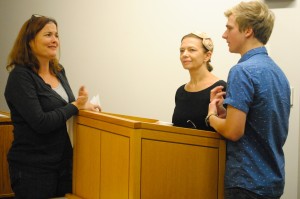By Yanling Xu
xuyanlin@grinnell.edu
Direct from Pomona College, Russian professor and scholar Larissa Rudova arrived in Grinnell last Friday, September 28, with a bag full of teenage girls’ books to give a speech on Russian culture. Rudova delivered a talk to the Kallaus Lecture Hall on “Post-Soviet Cinderellas” and fiction written for teenage girls after the fall of the Soviet Union, giving a detailed image of Russian culture at that time.

The hall held about 50 participants, from professors in different departments to students interested in Russian culture. The lecture lasted for 50 minutes, discussing two adolescent novels from 2001 and 2005, both of which involve beauty contests.
At that time, the new principle of beauty for girls involved not natural appearance, hygiene and absence of makeup, but neatness, professionalism and modesty. In these tales, authors try to educate adolescent girls to use the consumer culture of beauty appropriately to achieve social standing.
In fact, Russian novels for children and teenagers have changed a lot in the last twenty years. After the fall of the Soviet Union, with the spread of the image of new femininity, privilege, self-indulgence, graciousness, social success, sexuality and material enjoyment, Russians have become eager to indulge in western fashion and modern techniques.
In this context, works of fiction for girls should be considered not only as literature, but also as literary commodities.
As a particular style, such fiction began to thrive during the first decade of this century.
“This type of popular literature for teenagers is a new phenomenon, because it’s specified in books written specially for girls,” said Kelly Herold, Russian. “That generally tells a lot about Russian society.”
What Rudova conveys is something cultural about different parts of world. The tales went beyond commodities—the heroines inspired females to be creative and independent.
“I think it’s interesting to see how being a teenager is far different in different places,” Herold said. “It gives students something that can reflect back what their teenage lives were like, what they read and what those books meant to them.”
Literature for children and adolescents is important because it transmits a country’s values.
Rudova is part of a working group set up by scholars from different schools to study Russian children’s literature and culture. They concentrate on transmitting the national and cultural ideals to children.
“Studying the same phenomenon in another country can tell us similar things or different things about that culture,” Herold said.
During the Soviet period, Russian children’s books focused on collective work and society. Interestingly, developments in Russian literature have not completely abandoned Soviet ideals.
“Now it’s actually going back to that idea [of working together],” Herold said. “American children’s books have all focused on the solitary nature of the hero. For American teenagers, they should always solve problems by themselves without the help of their peers.”




























































